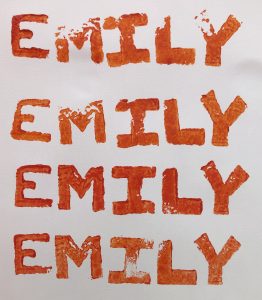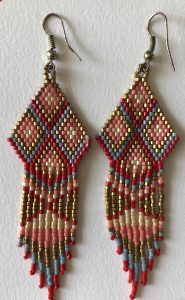I was curious and felt intrigued by the idea of the potato press, and even though I did see it as a waste of food initially, I was excited to try the process. After watching Paul Collier in the youtube video, “Upside Down, Left To Right: A Letterpress Film,” I was captivated by the methodical rhythm of the printing press and the slow intentional process of arranging letter by letter before adding ink and rolling out the machine.
Here is an overview of my 10 minute process in 36 seconds:
My process of creating the letters took around five minutes, and then another five to experiment with paint and stamping. All the letters I chose were written in uppercase, and so I did not have to include curves and only needed to invert the letter L. I realized in the printing stage that some of my letters were not flat, and that my initial error had been not cutting the potato straight. The top left corner or the letter M had to be pressed down and similarly with the Y. When I initially pressed the letters down flat, all corners did not catch because of the uneven surface of the potato.

Letter design was challenging and expanding beyond straight edges and capital letters would have involved much more finesse. My first letter, E, is much smaller than the rest and the letters became more uniform as my name goes on. In my first attempt, I used acrylic paint, whereas in my second attempt I was able to achieve a more even print with less viscous paint.
I relate this process to art forms I am familiar with: beadwork, needlepoint/embroidery and screen printing. The mechanization of many aspects of our life and focus on the immediate consumption items that are mass marketed has created a separation from the creation of personal items such as, handmade prints for cards, clothing and jewelry. It was enjoyable to create the potato stamps and part way through, I started to smile, breathe calmly and enjoying the task. The process was predictable and therefore I could relax into the movements of cutting and shaping each letter. This process is very similar to the beadwork I make, as it is very relaxing once you have mastered the skill, but along the way, the learning process can be tricky. However, while beading I must still pay very close attention to the colour and shape of the beads I choose when weaving it into the earring. One mistake could mean that I will have to undo all your progress or redo the piece entirely. It is through these slow activities that we are able to connect with ourselves, our emotions and patience level. I believe the resurgence of handmade items allows people to develop a greater consumer consciousness and contribute to the movement of supporting local artists in their craft.



Hi Emily,
Really enjoyed your post. It’s interesting how you approached it so differently…let’s just say you have an artist’s perspective, as evidenced by the photos of your beadwork. I was more focussed on just getting the task done. Also what took you five minutes (carving the letters) took me nearly an hour! This was partially because I didn’t realize until too late I would have to invert the letters…again I attribute this to not thinking like an artist! Your comment about handmade items made me think of how the the emergence of print technologies made the book itself less valuable. Content became the focus. While this new technology did lead to incredible transformations in society, printed books eventually replace the amazing manuscripts copied by hand that were previously valued more. However I agree with you that there’s still a place for handmade items!
Hey Emily,
Thanks for mentioning food waste! It was something I thought about as well during the process – especially in a globalised world of food. I wondered how far my potatoes had travelled and lived before getting to be and being “discarded” rather than eaten, even if they did still serve a different purpose.
Your timelapse was cool, too! What tools are you using? I just went with a good ol’ craftknife 😀
Finally, your statement “The mechanization of many aspects of our life and focus on the immediate consumption items that are mass marketed has created a separation from the creation of personal items such as, handmade prints for cards, clothing and jewelry.” really made me smile. Moving away from immediate consumptions towards creation of personal items is a trend I’ve been noticing amongst my circles, and I love it. There are even a few of us writing one another letters and postcards again, even though they take so much longer to get somewhere than an email or DM ever would, because they are just such a different experience to send and received.
Really really enjoyed this post! Thanks 😀
Hi Emily,
I felt there was a joy in creation and in the imperfections which make the handcrafted printing all the more valuable. I agree that the actually printing very relaxing and would add also addictive despite all the labour involve to get to that point. One of my letters was less than flat also and I had to carefully rock it to get a full imprint. I am not sure why I didn’t try to re-carve it flat. The footprint of one’s creation is an interesting idea which I hadn’t thought of at first. I did managed to reduce what I was using by cutting potatoes in half and then as I made mistakes, cutting the half flat and starting again (a good thing because I did make a lot of mistakes). I also compost the left overs so it was not a total waste. The environmental impact of technology is an interesting consideration.
Hi Emily!
I love how you recorded a time-lapse video of your process – very creative! I also have experience with printmaking and found the process to be relaxing and calming.
Thanks for sharing!
Robin